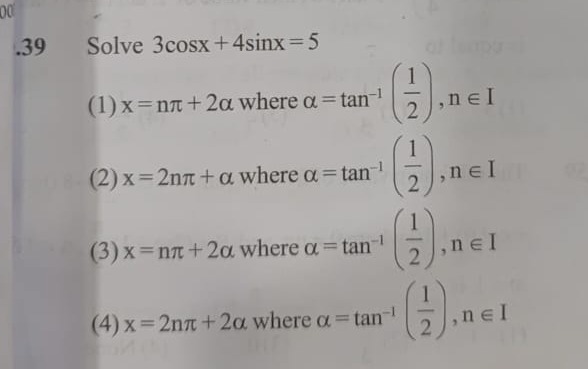Question
Question: Solve 3cosx + 4sinx = 5...
Solve 3cosx + 4sinx = 5

x = nπ + 2α where α = tan⁻¹(21), n ∈ I
x = 2nπ + α where α = tan⁻¹(21), n ∈ I
x = nπ + 2α where α = tan⁻¹(21), n ∈ I
x = 2nπ + 2α where α = tan⁻¹(21), n ∈ I
x = 2nπ + 2α where α = tan⁻¹(21), n ∈ I
Solution
The given equation is 3cosx+4sinx=5. We can solve this using the substitution t=tan(x/2), where cosx=1+t21−t2 and sinx=1+t22t. Substituting these into the equation gives 3(1+t21−t2)+4(1+t22t)=5. Multiplying by (1+t2) yields 3(1−t2)+8t=5(1+t2), which simplifies to 3−3t2+8t=5+5t2. Rearranging into a quadratic equation gives 8t2−8t+2=0, or 4t2−4t+1=0. This factors as (2t−1)2=0, so t=21. Substituting back t=tan(x/2), we have tan(x/2)=21. Let α=tan−1(21). Then tan(x/2)=tan(α). The general solution for tanθ=tanβ is θ=nπ+β. Therefore, 2x=nπ+α, which gives x=2nπ+2α. Substituting the value of α, we get x=2nπ+2tan−1(21).
